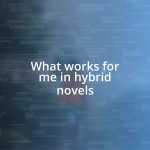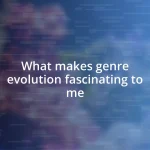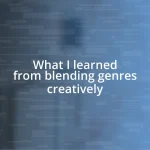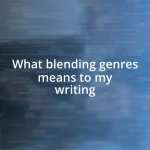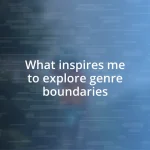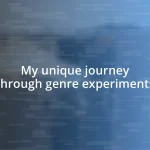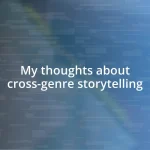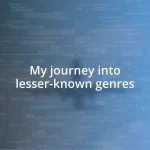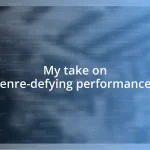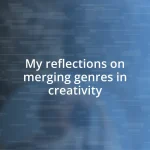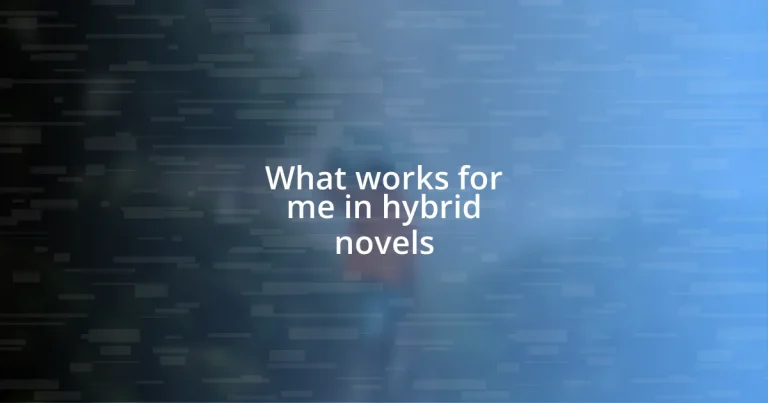Key takeaways:
- Hybrid novels effectively combine various narrative forms, such as prose, poetry, and visual elements, enhancing emotional depth and reader engagement.
- Character development in hybrid stories benefits from multi-faceted portrayals, allowing for deeper connections through diverse storytelling methods.
- Successful hybrid writing requires intentional integration of different formats and a cohesive narrative structure to create an immersive reading experience.
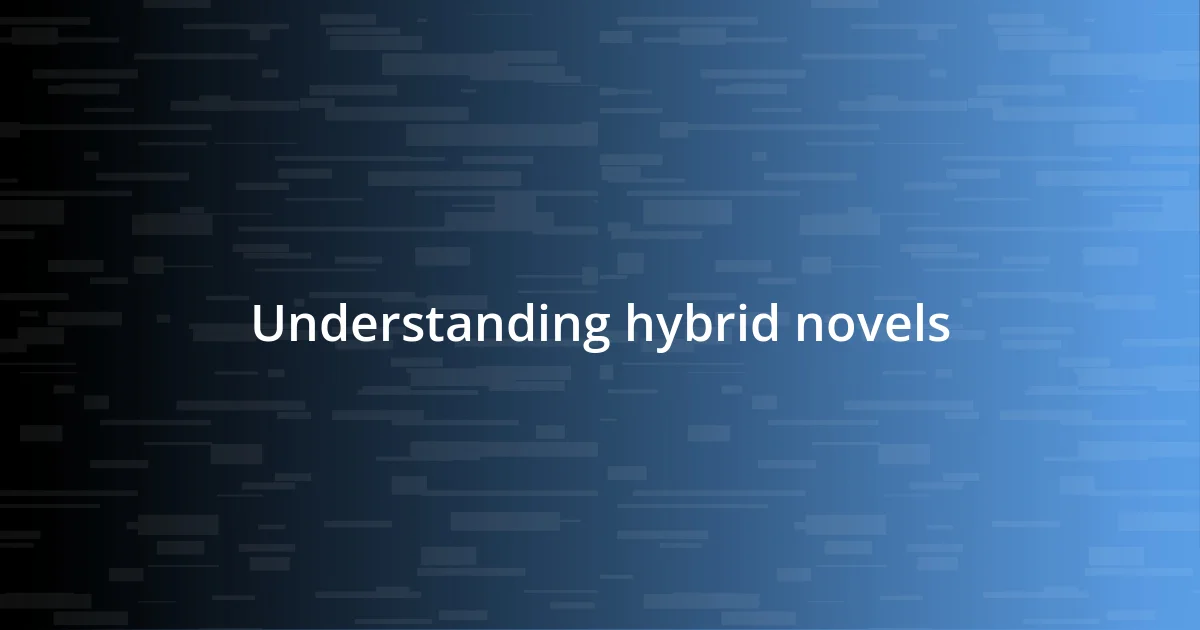
Understanding hybrid novels
Hybrid novels are a fascinating fusion of genres, combining elements of prose, poetry, and visual storytelling. I still remember the first time I stumbled upon a hybrid novel; it was like finding a hidden treasure where every page offered something new and unexpected. Can you imagine the thrill of flipping through a book that could make you laugh, cry, and ponder all at once?
These novels break traditional boundaries, encouraging creativity and experimentation. I often wonder how authors decide which elements to intertwine—do they start with a theme or an emotion? Personally, I find that the most compelling hybrid works often stem from a desire to capture complex emotions that can’t easily be expressed through one medium alone.
By embracing the unconventional, hybrid novels invite readers into a more immersive experience. I’ve felt drawn into stories where visual elements complement the narrative, creating a richer atmosphere. It’s as if the book whispers, “Here’s a different way to see the world,” and I can’t help but agree.
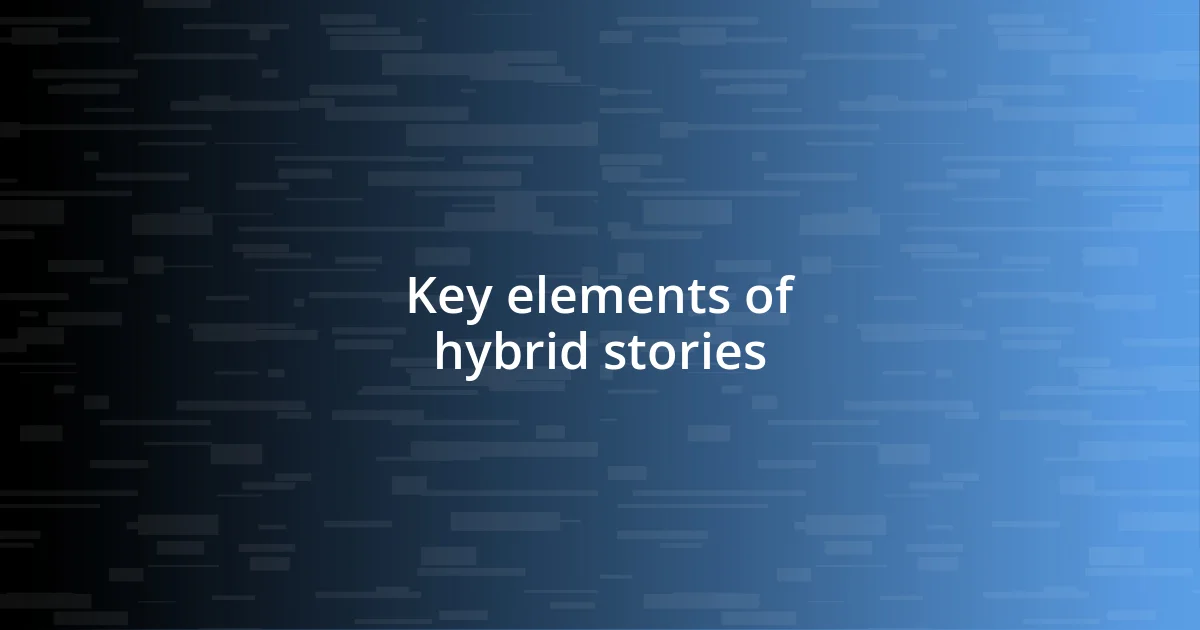
Key elements of hybrid stories
The key elements of hybrid stories often revolve around the combination of different narrative forms. I’ve noticed that successful hybrid novels tend to leverage visual components, such as illustrations or photographs, which can evoke strong emotions or enhance themes. For example, I recently read a book where the author included handwritten notes from a character, and it made the story feel so much more personal, almost as if I was peering into someone’s diary.
Moreover, pacing plays a vital role in hybrid narratives. I feel that blending poetry with prose can create a rhythm that draws readers in, allowing them to savor moments or speed through action. When I encounter a beautifully written poem nestled within a chapter, it often takes my breath away, slowing me down to reflect on its meaning before moving forward.
Character development, too, is crucial in hybrid stories. Characters often need to be multifaceted to seamlessly interact with various forms of storytelling. I remember feeling captivated by a protagonist whose journey unfolded through a mix of comic strips and narrative prose. This multifaceted approach made the character’s growth feel incredibly dynamic and relatable.
| Element | Description |
|---|---|
| Visual Components | Incorporation of illustrations or photographs to evoke emotions. |
| Pacing | Combination of different narrative forms to create a unique flow. |
| Character Development | Multipronged characters depicted through various storytelling formats. |
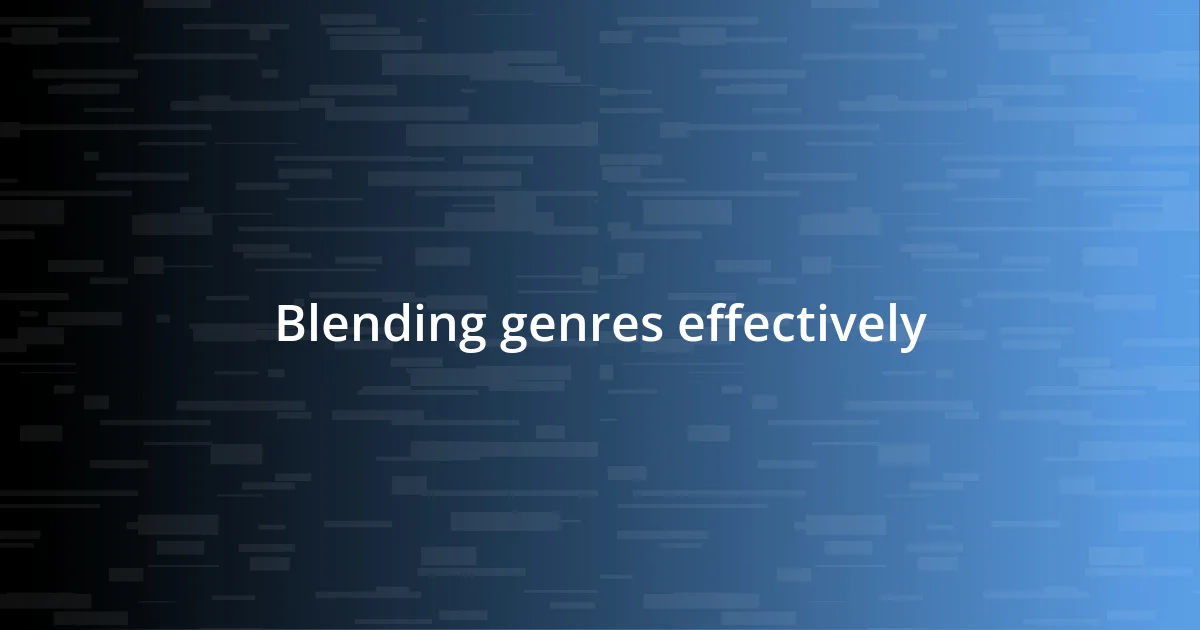
Blending genres effectively
When it comes to blending genres effectively, I think it’s all about striking the right balance. For instance, I recently dove into a novel that shifted from poignant prose to sharp, witty dialogue, leaving me a bit breathless but also deeply engaged. It was incredibly rewarding to see how humor could lighten a heavy theme, making the reading experience not only rich but emotive.
- The fusion of contrasting genres can enhance emotional depth.
- Mixing styles encourages readers to view themes from multiple perspectives.
- Transitions between genres should feel seamless to maintain immersion.
- A hybrid approach allows for unique storytelling devices that captivate.
In my experience, some of the most powerful moments in hybrid novels come from surprising genre shifts. I remember reading a story that blended horror elements with whimsical illustrations. It was so jarring yet intriguing, and it forced me to reassess my feelings about both genres as they collided. This unexpected juxtaposition made the narrative stick with me long after I turned the last page, showcasing how effectively blended genres can evoke lasting impressions.
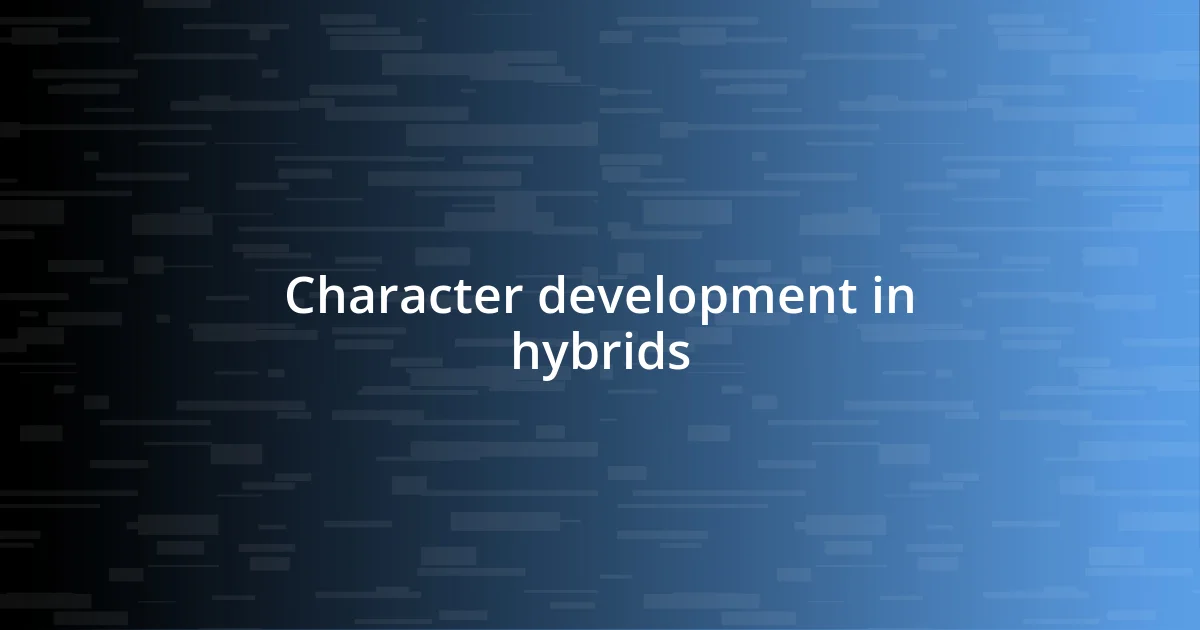
Character development in hybrids
Character development in hybrid novels stands out for its complexity. I’ve often found that characters resonate more deeply when their stories unfold across different mediums, like when a character’s evolution is illustrated both in the narrative and through artwork. It makes me wonder: doesn’t seeing a character’s emotions visually enrich our understanding of their internal struggles? For instance, I remember a particular hybrid story where a protagonist’s arc was captured in comic panels that expressed her turmoil in ways words couldn’t fully articulate.
This multi-layered approach not only broadens the character’s personality but also invites readers into their world in a more intimate way. I appreciate how hybrid novels often challenge traditional character frameworks. In one novel I read, the protagonist’s thoughts were shared in diary-style entries interspersed with graphic scenes that illustrated pivotal moments, which kept me consistently invested. It’s as if I was privy to her thoughts while simultaneously witnessing her challenges, making her journey feel gripping and relatable.
Engaging with characters through diverse storytelling formats enriches our experience as readers. There’s something profoundly impactful about witnessing a character grapple with their identity through a blend of prose and visual elements. I felt a strong connection to a storyteller who shared her past by alternating between detailed narratives and evocative sketches. This approach transformed her character into a vibrant, multifaceted being rather than just ink on a page. Don’t you find it rewarding when characters develop through such intricate layers? It creates an emotional tapestry that lingers well beyond the final chapter.
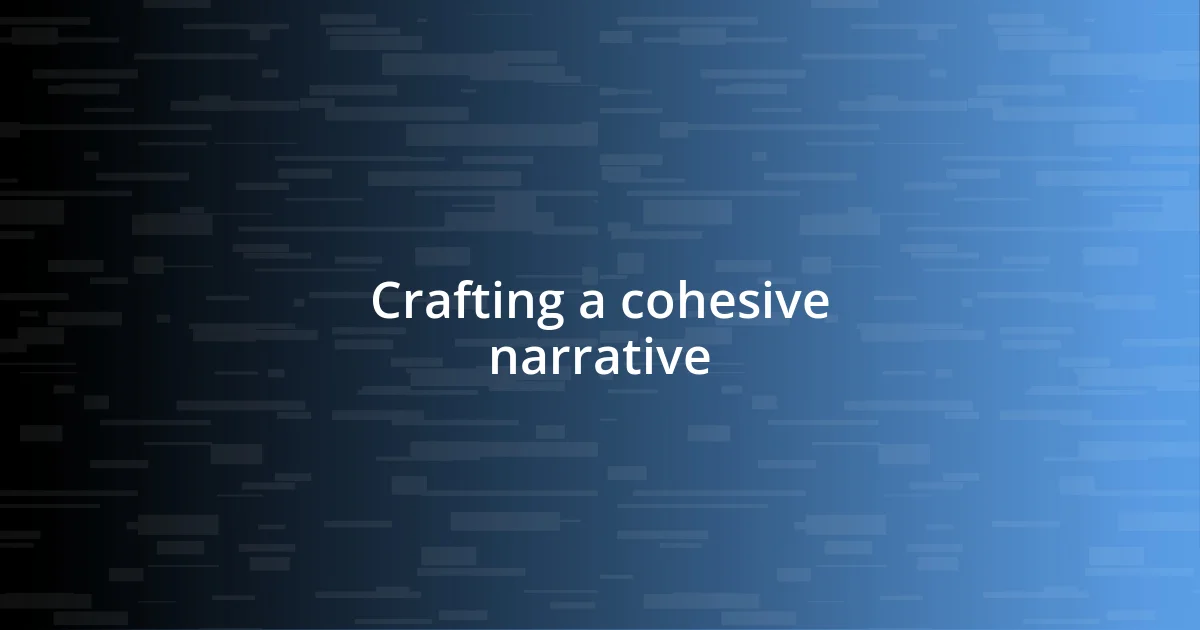
Crafting a cohesive narrative
Crafting a cohesive narrative in hybrid novels often feels like piecing together a puzzle, where every section must fit perfectly to create the bigger picture. I recall reading a novel that intertwined poetry and prose, and I was amazed at how the lyrical moments enhanced the narrative’s emotional resonance. It really made me think: how does the rhythm of language influence our connection to the story?
Transitioning between different formats can be tricky, but when done right, it generates a sense of harmony that captivates the reader. For instance, I once enjoyed a story that blended short chapters with images, each image revealing layers of meaning related to the text. This arrangement not only maintained engagement but also allowed me to appreciate the subtleties of the narrative that might have otherwise gone unnoticed. It’s quite fascinating how a well-placed image can evoke emotions that words sometimes struggle to convey, isn’t it?
I find that a strong thematic thread weaves through all the elements in a hybrid narrative, connecting different genres and styles. I remember a compelling tale where the overarching theme of loss was depicted through diverse storytelling techniques, from stark prose to vivid illustrations. It left a mark on my heart; I was emotionally invested in each character’s journey, which felt enriched due to the varied formats. In my opinion, when every component of the narrative works in concert, the story not only flows better but transforms into a more profound experience for the reader.
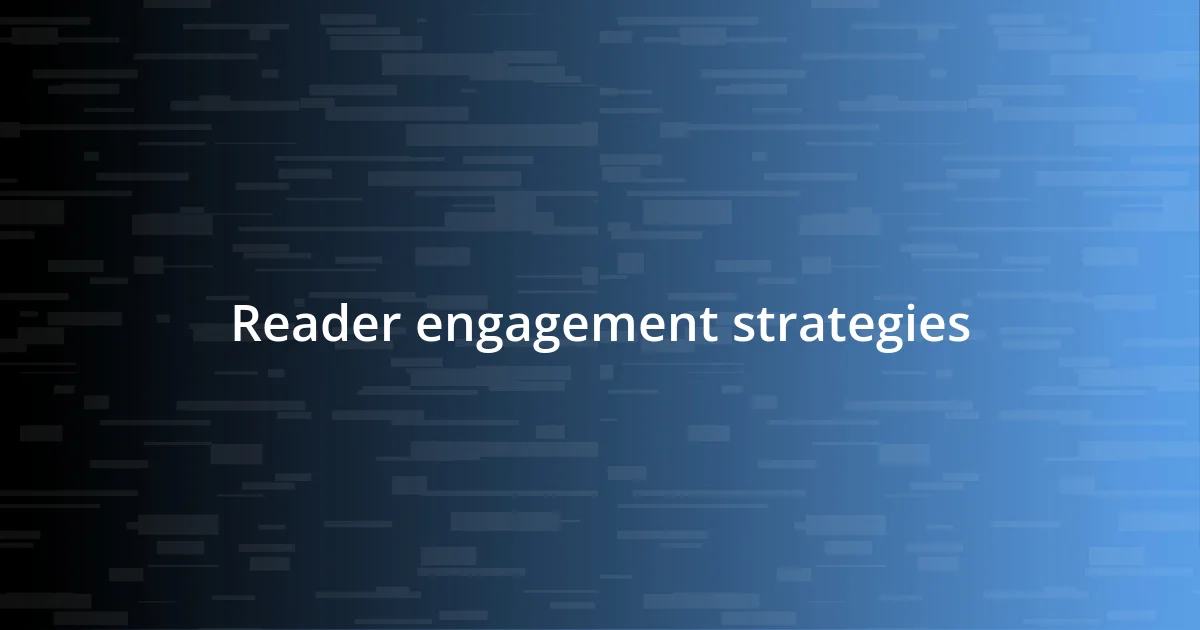
Reader engagement strategies
Reader engagement strategies in hybrid novels can elevate the reading experience in powerful ways. I’ve often found that the incorporation of multimedia elements—like videos or interactive features—adds another layer of involvement. For example, during a recent read of a digital hybrid novel, I discovered a scene where clicking on a specific image unlocked a short animation that provided backstory. It was as if I was given a front-row seat to the character’s previous experiences; it pulled me in and deepened my connection. Have you ever felt that surge of excitement when engaging with a story in a way that feels truly immersive?
Then there’s the art of pacing and suspense, which I believe is uniquely amplified in hybrid formats. In one novel, the alternating styles kept me on my toes; just when I thought I understood the direction of the story, a beautifully crafted graphic panel shifted my perspective entirely. It reminded me that visuals can manipulate time and tension, almost like a cinematic moment that leaves you breathless. Doesn’t the thought of experiencing such twists, where visuals and text harmonize, make you crave that rush of curiosity with every turn of the page?
Finally, fostering community involvement can be a game-changer. I’ve participated in online discussions about hybrid novels where readers shared interpretations of illustrations versus the text, and this collective analysis deepened my appreciation for the story. It felt rewarding to see how others connected with different aspects, sparking a conversation that transcended the book itself. How stimulating is it to realize that our interpretations can vary so widely, fueling a shared passion that binds us as readers? When readers contribute their voices, it transforms solitary reading into an enriching dialogue.
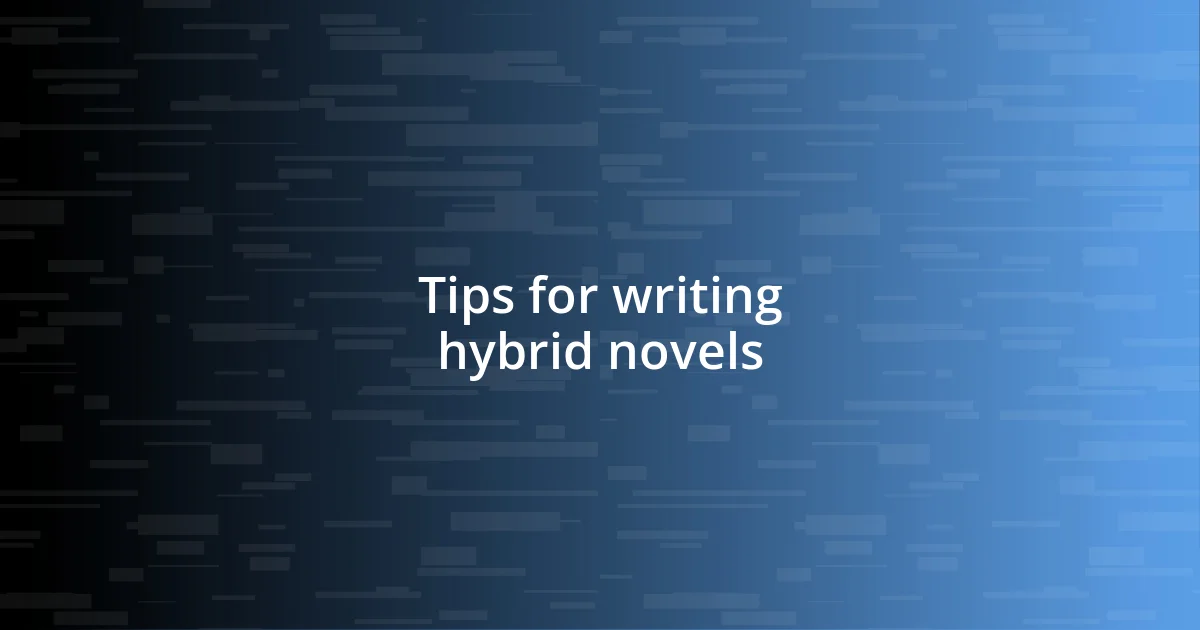
Tips for writing hybrid novels
When writing hybrid novels, I’ve found that blending formats requires a clear vision. Recently, I started crafting a story that intertwines a traditional narrative with diary entries. This structure not only provided a glimpse into the character’s inner thoughts but also added a layer of intimacy that pulled me deeper into their world. Have you ever noticed how such reflections can create a powerful bond between the reader and the protagonist?
I also believe that experimenting with spacing and layout can make a significant difference. In one project, I laid out text in unique shapes to echo the emotions being conveyed. It was exhilarating to watch the words visually dance across the page! This approach not only showcased my creativity but also gave readers a fresh way to engage with the narrative. Isn’t it thrilling to think about how the physicality of the text can enhance storytelling?
The key, in my experience, is to integrate diverse elements intentionally. I remember when I wove in snippets of interview transcripts within my narrative, giving readers varying perspectives on the main events. It felt like a conversation among the characters that enriched the storyline and made it feel more authentic. How often do you encounter narratives that leave you pondering multiple viewpoints? Embracing this multi-dimensional approach can elevate a hybrid novel, ensuring it resonates on multiple levels.
